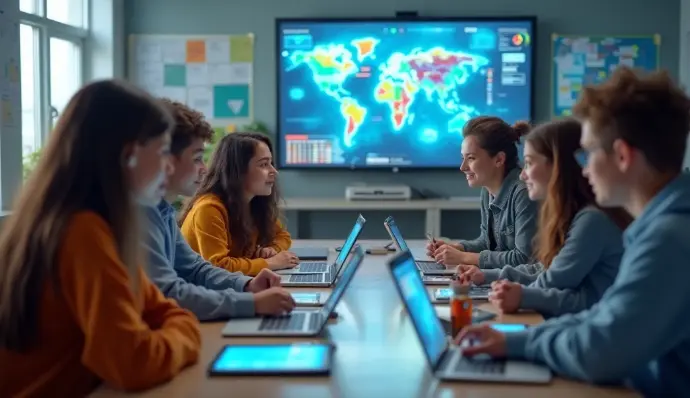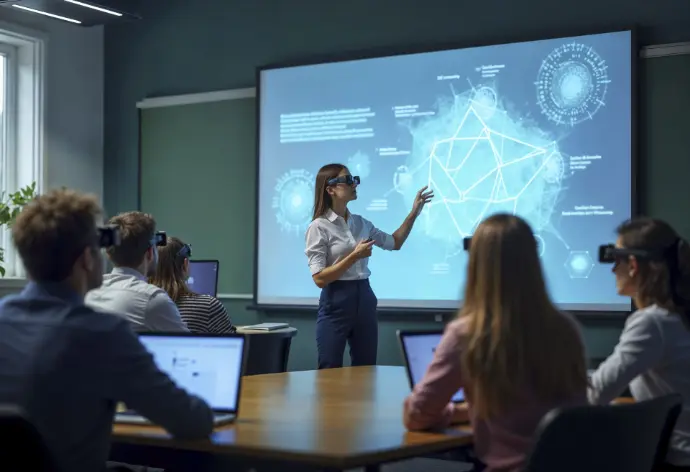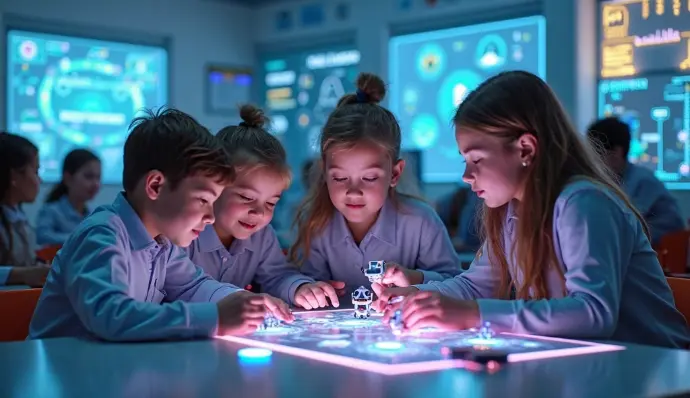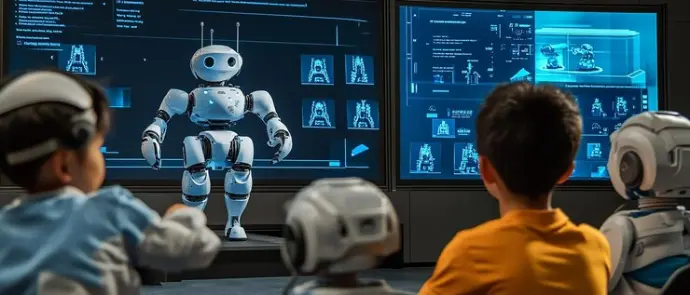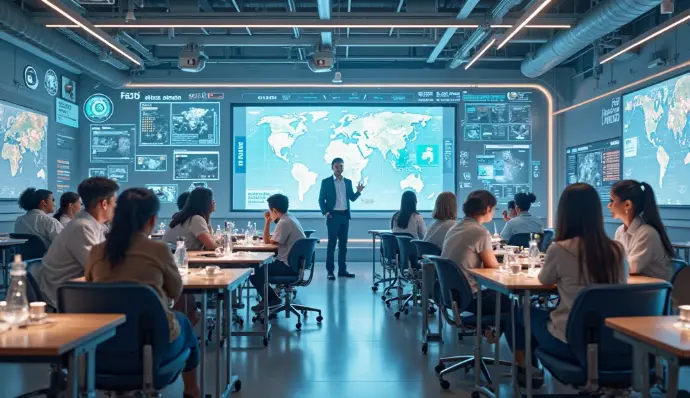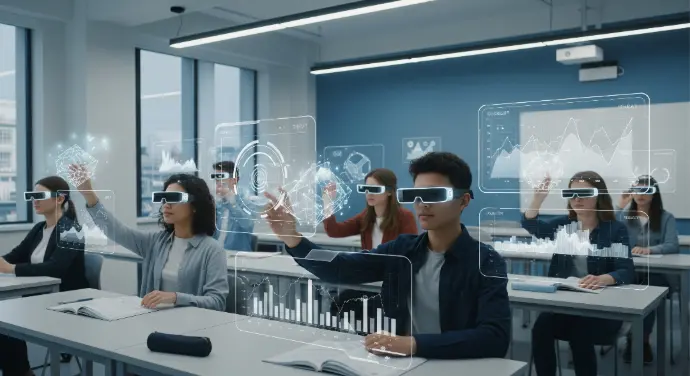Artificial Intelligence in Education
Artificial Intelligence (AI) provides the potential to address some of the biggest challenges facing education today, innovate teaching and learning practices, and accelerate progress towards achieving SDG 4. However, rapid technological developments inevitably bring with them multiple risks and challenges, which have so far outstripped political debates and regulatory frameworks.

Artificial intelligence is a term that sounds like science fiction, but in reality it is something that is already present in this 4.0 society in many areas of life. There are several definitions of Artificial Intelligence, but in general it could be said that it is a branch of computer science in which sets of orders capable of carrying out human actions are studied, taking into account two characteristics: reasoning and behavior. This means that a machine can use information it receives from external events to decide which is the best action to reach the final objective satisfactorily. In the same way, they could take into account the errors made to change their behavior in subsequent events. Since the time of Aristotle, artificial intelligence has been talked about, although from the field of philosophy and imagination. However, the first definition was coined in 1956 since until then there was no clear consensus. From then on, and thanks to the development of technology and specific languages, it evolved much faster. In fact, in 1997 the world chess champion lost against an autonomous artificial intelligence called Deep Blue. From that moment on, different artificial intelligences began to appear that were superior to humans at playing logic games, with less reaction time and greater efficiency. Thus we arrive at the year 2017, when for the first time the Touring test was passed, in which a human was unable to recognize a computer in a blind conversation.
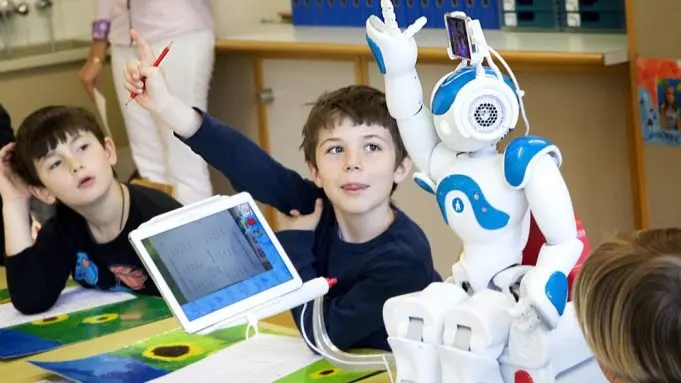
Uses of AI in education
What interests us is how we can apply this technology in the education of children. In this field this technology is not yet widely exploited but we can find several examples of its use:
- Language learning. It consists of using the correction of answers to enhance the errors in the following questions in such a way that it reinforces more the parts in which the student fails. In this way the user is not only evaluated by his/her correct answers but also learns from his/her own mistakes.
- Information assistance bot from the CEU Cardenal Herrera University in Castellón. It consists of artificial intelligence to solve the doubts that users may have in the area of schedules, documentation and registrations.
- Machine Learning also has a place in education today in projects such as Eduband developed by Carnegie Mellon University in Pittsburgh. In this project they work with all the variables that intervene in the education of students in order to adapt the educational tools to the needs of the students.
Advantages of AI in education
Disadvantages of AI in Education
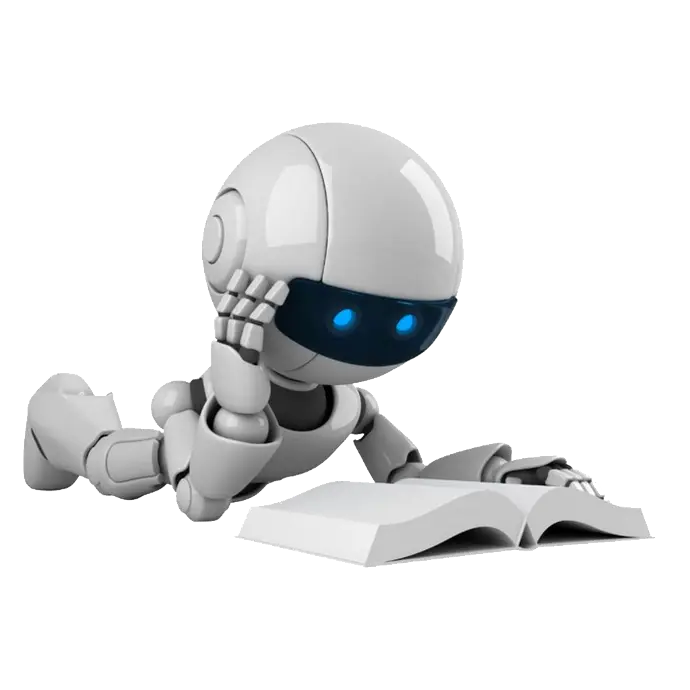
This new technology can bring us many advantages when it comes to educating our children, since we can move from a generic education applied in the same way for all profiles to a personalized education tailored to the student.
- Analysis of data referring to a child in a specific education. Artificial Intelligence can be used to analyze this mass of data from each student as individuals and as a group in order to decide which methodologies or tools should be used with each group and with each student in particular so that the learning process is the most efficient.
- Putting an end to the repetitive tasks that teachers perform and that involve a time and energy burden that could be used in other more specific or individual processes. These processes, exam corrections or personal work, can be carried out by systems more quickly and with more precision than the teachers themselves, obtaining transversal data from each student that could be used for the study of their subsequent education.
- Promote collaborative learning, since like-minded groups can be created to carry out tasks together, increasing the effectiveness of learning. Artificial Intelligence can study the abilities of each student and create groups with deficiencies that can be solved or complemented by the knowledge of other like-minded members.
- The advantages of applying Artificial Intelligence are many. In fact, there are so many that they could mark a before and after in the evolution of teaching. It is not difficult to reach the conclusion that just as society and technology advance, education has to do so at the same pace.
Artificial intelligence (AI) has revolutionized the way we learn and teach in education. However, despite its benefits, it also presents disadvantages and risks that need to be carefully considered and addressed. In this article, we will explore some of the main disadvantages of artificial intelligence in education.
- Lack of empathy and emotional understanding
One of the most significant disadvantages of artificial intelligence in education is its lack of empathy and emotional understanding. Although AI can analyze data and personalize learning content, it lacks the human ability to empathize and understand students’ emotions. This can limit its ability to provide emotional and social support to students and create a meaningful connection with them. Education is not just about acquiring knowledge and skills, but also about developing social and emotional skills. Interaction with teachers and peers is critical to students’ emotional growth. AI can automate certain tasks, but it cannot replace the human interaction and emotional support that teachers can provide.
- Bias and discrimination
Another major disadvantage of artificial intelligence in education is its potential to perpetuate inequality and bias if not used ethically and responsibly. AI algorithms can be influenced by the biases and opinions of their creators, which can lead to unfair and discriminatory outcomes. For example, if an AI algorithm is trained on historical data that reflects discrimination, the algorithm is likely to reproduce that bias in its analysis and decisions. This can have a negative impact on the equity and impartiality of the educational process, especially for students belonging to marginalized or minority groups.
- Reliance on data and technology
Artificial intelligence in education relies heavily on accurate data and reliable technology. If the data used is incorrect or incomplete, AI can provide misleading or inadequate information. Furthermore, if technology fails or is unavailable, teachers and students may struggle to access the information and resources needed for learning. This poses a challenge in terms of accessibility and equity. Not all students have equal access to technology and digital resources, which can create a digital divide and exacerbate existing inequalities in education.
- Impact on teachers’ employment
AI also has an impact on the employment and job security of teachers and other education workers. If AI automates administrative and teaching tasks, some jobs may be eliminated or reduced. This raises concerns about the future of the teaching profession and the need to adapt and acquire new skills to work with AI. While AI can improve the efficiency and effectiveness of education by automating certain tasks, it is important to find a balance between automation and human presence in the classroom. Teachers play a crucial role in education, not only as transmitters of knowledge, but also as mentors and tutors for students. While artificial intelligence has the potential to revolutionize education by personalizing learning and automating administrative tasks, it also presents disadvantages and risks that must be carefully considered and addressed. It is essential to ensure that AI is used ethically and responsibly, ensuring fairness and impartiality in its use. In addition, it is necessary to provide adequate training for teachers and students, so that they can interact effectively and safely with AI. Education is not just about acquiring knowledge and skills, but also about developing social and emotional skills that can only be provided by human teachers and peers. By addressing these disadvantages and risks, we can fully harness the potential of artificial intelligence to improve education and learning for all.
Learners and teachers are certainly using AI for different purposes: to create, to write, to program, and much more. AI provides new avenues to explore and seek help on certain topics, but it also provides shortcuts.
On most standardized tests, new generative AI systems with large language models score better than the average student, often placing in the tenth or even first percentile. This is something that is forcing school systems to rethink normal assessment methods and will drive innovations in how learning is measured. In other words, it is about rethinking the way we learn and teach, and therefore how learners are taught and what they should prioritize.
But despite all these uses, the benefits that technology can provide remain largely in the realm of hope and expectation. There is no solid evidence yet that generative AI applications such as ChatGPT improve learning performance.
AI is often seen as a tool for creating personalized learning experiences. We believe in this potential, but we also believe that education is a collective and social effort, and schools are where children socialize and learn to live together.
In addition to supporting teaching and learning, AI is used to automate various administrative tasks, such as grading and monitoring attendance and performance. This development could ease the administrative burden on teachers and, if carefully managed by well-trained and qualified operators, can be a positive step forward. At the same time, the IMF has raised the alarm about the risk that 60% of new jobs will be replaced and/or affected by AI in the near future. That is why our motto is “leading technology so that it does not lead us.” In any field, we need to remain open to innovation and prepare well rather than remain stuck in a defensive position for the future.
We need to openly ask ourselves difficult questions such as: Should AI be used to decide university admissions? To read and annotate students’ work? To indicate their strengths and weaknesses? To help students while taking exams (as is now the case with calculators and word processors)? The mother of all these questions is who decides what and for what purpose, and this is where UNESCO’s vision comes in: technology is not neutral and must be directed by our will. Technology on our terms is applied on our terms, as highlighted in our latest edition of the Global Education Monitoring Report, which focuses on technology in education.
The advantages that AI provides are not always worth the cost. For example: there is no doubt that AI systems can read and respond to student work more quickly and effectively than real teachers. But what about the quality of these responses? This is the approach that we, governments and UNESCO partners, regularly emphasize.
There are also bright spots and positive ways to apply AI. This is especially true in research on big data, which is already yielding exciting advances. AI tools, to name just one example, have made it easier to model almost every protein known to science. This is very good news, as it shows us what is possible when humans use AI for good and keep a careful eye on the technology.
The application of AI in education varies widely from country to country, often reflecting existing disparities in technological infrastructure, funding, political support and levels of digital literacy. Developed and wealthy countries may have a stronger technological infrastructure, as well as an innovation ecosystem that includes the private sector. This ecosystem supports schools and universities to lead experiments in AI in education. But this is not the case in the Global South and, more broadly, in developing countries, which face fundamental challenges related mainly to the basic prerequisites for technology to be functional for quality education, from infrastructure to electricity.
Against this background, I see two key priorities for technology to fulfil its own long-term role of “bridging the gap” for all. First, it is about ensuring that investments can truly bridge the existing digital divide, in terms of connectivity, content and capacity. More than half of the world remains unconnected, while the other half is developing the next generation of AI tools thanks to unprecedented investment from the public and private sectors. On the other hand, human capabilities will be decisive in driving the technological revolution. That is why the digital capabilities of teachers and students must be prioritized in the development of curricula, and digital literacy must be part of the basic skills that all citizens must have in the future, regardless of their age, educational level and social position.
The application of AI in education varies greatly from one country to another, often reflecting existing disparities in technological infrastructure, funding, political support and levels of digital literacy. Developed and rich countries can count on a stronger technological infrastructure, as well as an innovation ecosystem that includes the private sector. This ecosystem supports schools and universities to lead experiments related to AI in education. But this is not the case in the Global South and, more broadly, in developing countries, which face fundamental challenges related above all to the basic prerequisites for technology to be functional for quality education, from infrastructure to electricity.
In this context, I see two key priorities for technology to fulfil its own long-term role of “bridging the gap” for all. First, it is about ensuring that investments can truly bridge the existing digital divide, in terms of connectivity, content and capacity. More than half of the world remains unconnected, while the other half is developing the next generation of AI tools thanks to unprecedented investment from the public and private sectors. On the other hand, human capabilities will be decisive in driving the technological revolution. That is why the digital skills of teachers and students must be prioritised in the development of curricula, and digital literacy must be part of the basic skills that all citizens must have in the future, regardless of their age, educational level and social position.
Secondly, we must focus on inclusion. To ensure that AI technology improves educational opportunities for all and contributes to bridging the gap that already exists rather than widening it.
While technology is not neutral, as mentioned above, decision-making is and will remain our responsibility as human beings. We can decide what kind of future we want, and this requires a radical shift in our relationships with nature, technology, and each other. When it comes to technology, including generative AI, we can decide to unleash the potential by taking ethics, safety, and inclusion more seriously, or we can choose to protect ourselves and our future from technology by banning it and trying to buy time. AI certainly provides groundbreaking opportunities to enrich and transform educational experiences. But as we do so, prioritizing ethical considerations and preserving education as a human-centered, social endeavor will be crucial. In other words, it’s about finding the right balance between blind fanaticism and outright inaction, and I’m cautiously optimistic about that.
The red lines relate to protecting privacy and personal data, ensuring that student users cannot be manipulated, and maintaining a constant focus on security, especially for children leaving compulsory education. Schools must be safe in both their digital and physical environments, and reflect the recognition that students constantly go through these stages.
UNESCO’s recent guidance on the use of AI in education and its broader Recommendation on the Ethics of Artificial Intelligence both revolve around the need to ensure the ethical use of AI and prevent bias, especially in interactions with minors. An age limit of 13 years should be set for the use of AI tools in classrooms and teachers should be required to be trained on this topic.
Finally, our recent publication “Technology: A Tragedy for Education?” highlighted the dangers posed by the unregulated use of technology in education in its analysis of the modalities of educational technology in learning used during the COVID-19 pandemic.
A fundamental goal of education is to help young people develop knowledge, awareness and, consequently, behaviours that enable them to live in harmony with each other, the planet and technology. Achieving these goals requires human guidance and instruction, something that technology can help to achieve more effectively.
The best way to achieve this is to use AI as a tool to complement, rather than replace, the human elements of teaching. Good human teachers and mentors play a powerful role in helping learners discover their personal strengths and develop their potential. They provide guidance and support that is sensitive to each learner and attentive to the particularities of the contexts in which each learner learns and lives.
AI is often claimed to be context-aware, but outside of narrow tasks, its contribution is limited compared to the awareness that teachers can bring to classrooms of the local community and culture.
Looking ahead, we need balanced approaches where AI supports educational processes while keeping humans in control.
Parents are understandably concerned, especially given the regulatory and policy vacuum around the use of AI in education and other settings. That said, we encourage parents not to become passive observers of the rapid evolution of AI and not to become defensive, but to engage with children where feasible, using AI applications for learning and other purposes. This ensures adult monitoring and can help children gain a more nuanced understanding of the strengths and limitations of the new technology – a valuable life skill in its own right. Fear alone is not an adequate perspective.
The AI regulations taking shape in the European Union represent a promising start to regulating the use of AI, including in the education sector. These regulations are a step forward in maximising the opportunities and minimising the challenges and dangers posed by AI technologies, while EU law lays the groundwork for more sector-specific AI regulations, which are clearly relevant in the field of education. We note that the EU has rightly classified education as a “high-risk” area for AI.
I think it is prudent to view these regulations as iterative, in the same way that innovators view technology. Regulators need to be as bold as the technology creators themselves. The regulations of the past are not sufficient for our era of accelerated technological development.
Overall, I am encouraged by the fact that many governments are now acting more quickly to set limits on AI than they have with respect to previous digital technologies, notably through the UNESCO Recommendation on the Ethics of AI, which preceded EU law in 2021 as the first global framework on this matter.
AI is shaping the future of the world and must therefore be considered and regulated as a global issue.

 IHRO NEWS
IHRO NEWS
